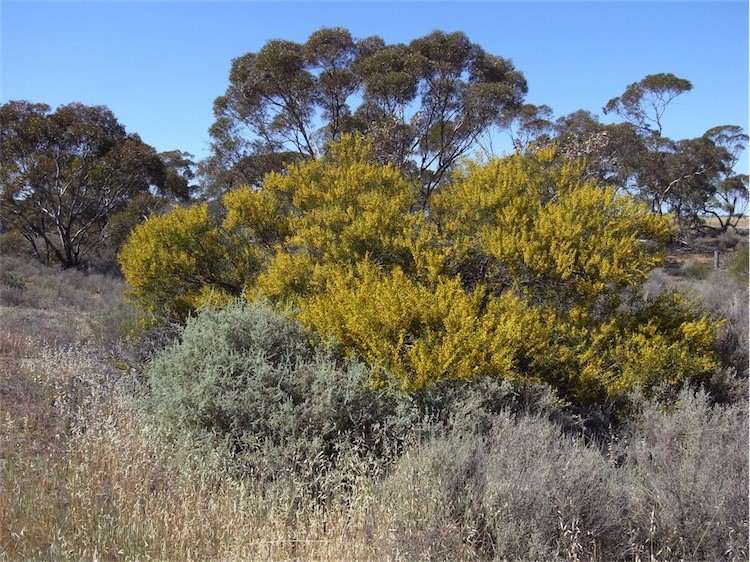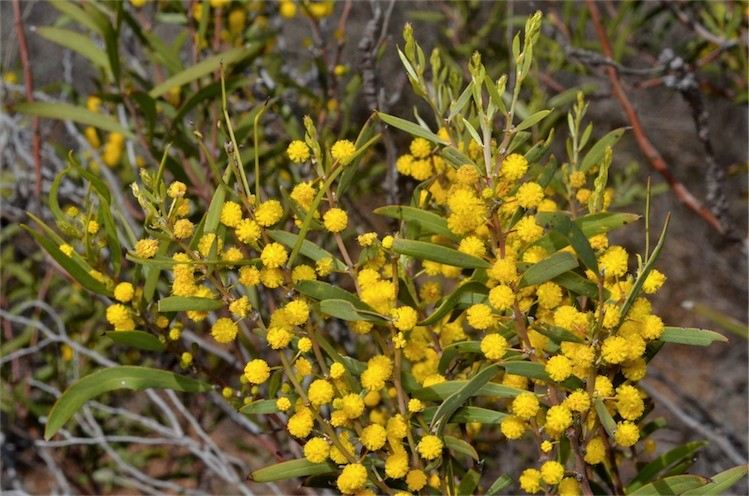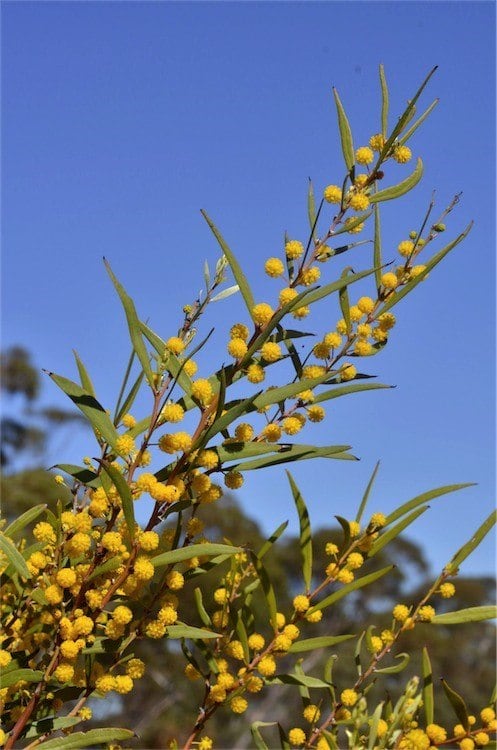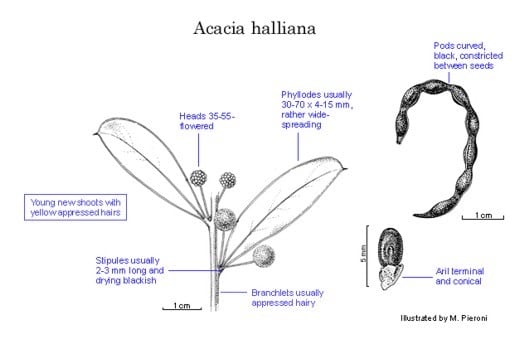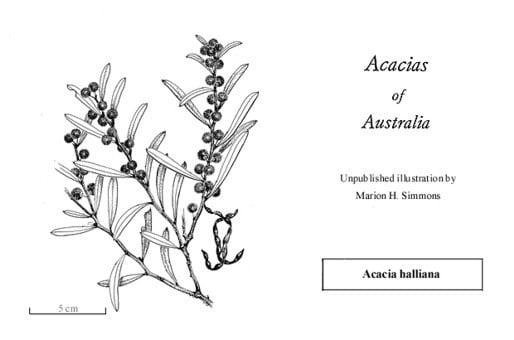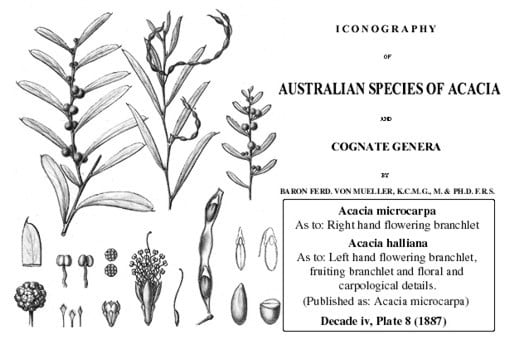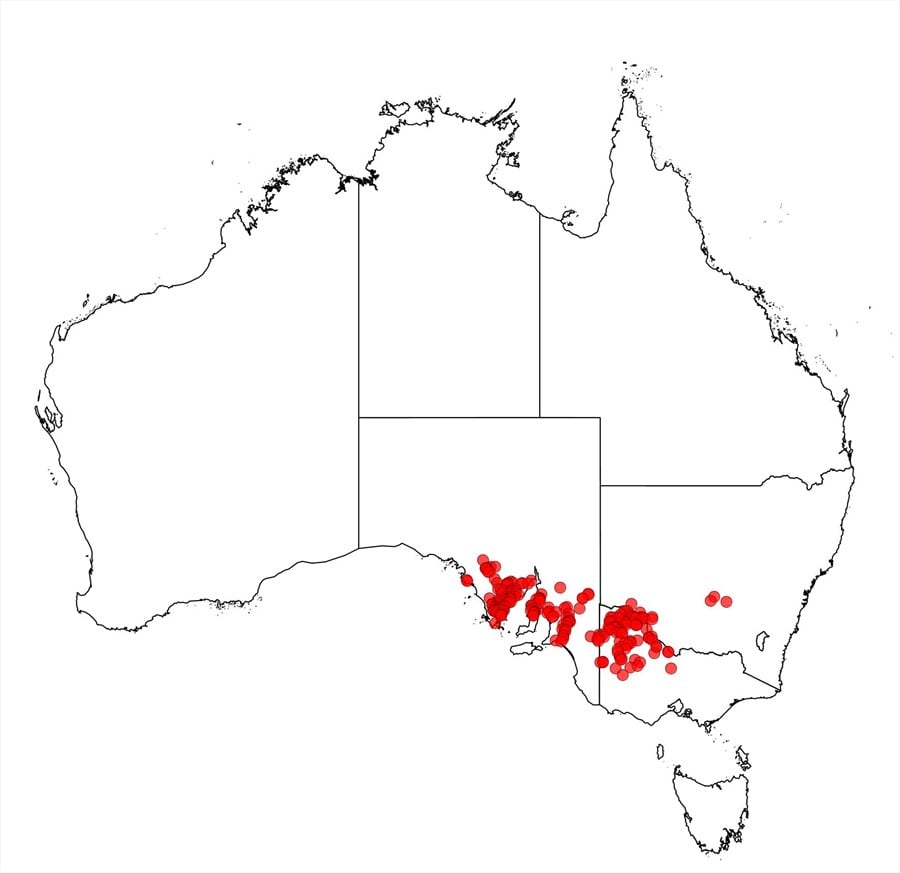Acacia halliana Maslin
WATTLE
Acacias of Australia
Family
Fabaceae
Distribution
Occurs in SE Australia from the Eyre Peninsula, S.A., E to Euston, N.S.W., and Gunbower, Vic.
Description
Bushy spreading shrub to 2.5 m high. Branchlets flattened and ±angled apically, soon terete and ribbed, appressed-puberulous, occasionally glabrous. New shoots pale yellow appressed-hairy. Stipules 2–3 mm long, brittle, often only bases persistent. Phyllodes ±inequilateral, narrowly oblong or narrowly elliptic, occasionally oblanceolate, straight to slightly recurved, (2–) 3–7 (–9) cm long, normally 4–15 mm wide, obliquely narrowed at apex to a ±straight, sometimes slightly pungent mucro, coriaceous, glabrous or (when young) sparsely appressed-hairy, 1-nerved per face; gland 5–12 mm above pulvinus. Inflorescences simple, commonly 2 per axil, or sometimes rudimentary, 1- or 2‑headed racemes with axes to 1 mm long; peduncles 5–10 mm long, glabrous; heads globular, 6 mm diam., (28–) 35–55-flowered, golden. Flowers 5-merous; sepals free. Pods submoniliform, ±curved to sigmoid, occasionally twisted at constrictions, to 6 cm long, 1.5–3 mm wide, firmly chartaceous to thinly crustaceous, black. Seeds longitudinal, oblong to elliptic, 3–4 mm long, dull, dark brown; aril terminal, conical, creamy white.
Habitat
Grows in mallee communities in sand or light brown calcareous loam.
Specimens
S.A.: c. 0.8 km N of Yeelanna, M.D.Tindale 579 (NSW, PERTH). N.S.W.: 41.8 km W of Balranald on Euston road, 11 Oct. 1947, E.F.Constable s.n. (NSW). Vic.: Big Desert, 9 km S of Murrayville on Nhill road, M.G.Corrick 6385 (MEL).
Notes
The second variant noted under A. halliana by B.R.Maslin in Fl. Australia 11A: 577 (2001) is now described as A. simmonsiana.
A taxon of uncertain rank from W.A. resembles A. halliana in having superficially similar phyllodes and persistent, long stipules (K.Newbey 9714 and 11815 from c. 50 km ENE of Ravensthorpe and S.D.Hopper 1961 from near Mt Ney, all PERTH); it has, however, pods that are flat, narrowly oblong and curved circinnately, enclosing smaller grey-brown seeds with a lateral aril. It may represent an undescribed infraspecific taxon of A. halliana or a new species related to it. The material at hand also resembles A. mutabilis subsp. stipulifera but it does not have the venation of that species and also differs in pod morphology.
Formerly confounded with A. microcarpa which has insignificant stipules, obtuse, glandular phyllode apices, ±clavate arils and fewer-flowered heads.
Acacia halliana is allied to A. merrallii which has thicker, shorter and proportionately broader phyllodes; it also has an orange or bright yellow aril enclosing to 1/3 of seed. A possible hybrid between the two species occurs on Yorke Peninsula, S.A. (8 km from Moonta on Maitland Rd, B.Copley 4753, AD). Also related to A. mutabilis which has similar venation but the adaxial margin has 2 nerves that coalesce above the gland; in addition, it has fewer flowers per head and ±terete pods, slightly or not at all constricted between the seeds.
One variant (not included in the description above) is recognised; it has atypically long peduncles (23–26 mm) and is found in the Gawler Ra., S.A. (e.g. A.E.Orchard 2314, AD) where the typical A. halliana also occurs, although not known to be sympatric.
FOA Reference
Data derived from Flora of Australia Volumes 11A (2001), 11B (2001) and 12 (1998), products of ABRS, ©Commonwealth of Australia
Author
Minor edits by B.R.Maslin, J.Reid & J.Rogers
B.R.Maslin
This identification key and fact sheets are available as a mobile application:
URL: https://apps.lucidcentral.org/wattle/
© Copyright 2018. All rights reserved.
